TOP 10 – BEST LONG RANGE WALKIE-TALKIES OF 2025
Licensed or long distance walkie talkies are the best walkie-talkies on the market: unlike licence-free walkie-talkies (PMR446), they allow users to communicate over a private and secure frequency. This frequency is assigned individually by OFCOM, the UK body which regulates telecommunications, as part of an annual or temporary subscription. These two way radios are specifically designed for the most demanding professions: they are more powerful and they have more advanced features than licence-free radios.
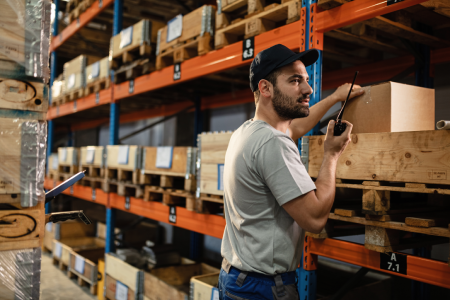
1

|
2

|
3

|
4

|
5

|
6

|
7

|
8

|
9

|
10

|
|
| ATEX certified | Without ATEX certification | Without ATEX certification | Without ATEX certification | - | Without ATEX certification | Without ATEX certification | Without ATEX certification | Without ATEX certification | Without ATEX certification | Without ATEX certification |
| Battery type | Lithium-Ion batteries | - | Lithium-Ion batteries | - | - | Lithium-Ion batteries | - | Lithium-Ion batteries | Lithium-Ion batteries | Lithium-Ion batteries |
| Channels - Sub-channels - Codes | - | - | 1000 | 16 | 58 marine channels, 10 weather channels, 36 programmable channels | 255 | 64 | 16 - 2 | 32 | 64 |
| Frequency | Licensed VHF | Licensed UHF | Licensed UHF | Licensed UHF | Marine VHF | Licensed VHF | Licensed UHF | Licensed UHF | Licensed UHF | Licensed VHF |
| IP Rating | IP68 rating | IP66 rating | IP54 rating | IP67 rating | IP68 rating | IP67 rating | IP55 rating | IP68 rating | IP54 rating | IP67 rating |
| Military standard | Confirmed to military standard | Not confirmed to military standard | Not confirmed to military standard | Not confirmed to military standard | Confirmed to military standard | Not confirmed to military standard | Confirmed to military standard | Confirmed to military standard | Confirmed to military standard | Confirmed to military standard |
| Size | 132 x 56 x 37 mm | - | 121 x 55 x 19.8 mm | 52,2×111,8×24,5mm (With BP-279) | 59.5 x 130 x 37mm | 115 x 55 x 35 mm | AC battery 125mm x 55mm x 36.8mm or short battery 125mm x 55mm x 31.7mm | - | - | - |
| Standby time / Talk time | Upto 21.5h | - | - | - | - | - | AC battery 19.5H / 26.5H - Light battery 17H / 22.5H | - | - | - |
| Use | For intensive use | - | For everyday use | For everyday use | For intensive use | For intensive use | For intensive use | For intensive use | For everyday use | For intensive use |
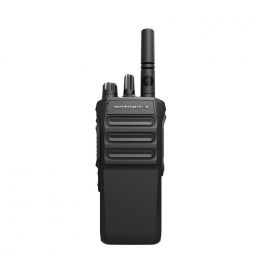
Motorola R7 Non-Keypad Capable VHF
The Motorola R7A is a durable, feature-rich two-way radio offering exceptional audio clarity and rugged construction, ideal for tough environments. It integrates seamlessly into Motorola's communication ecosystem for enhanced connectivity and functionality.
- Advanced noise cancellation and loud, clear voice transmission.
- Premium options for GNSS, Wi-Fi, Bluetooth, and more.
- Connects with Motorola's Safety Reimagined ecosystem.
- Advanced features only available in higher-tier models.
- Max 64 channels may not suitable for large operations.
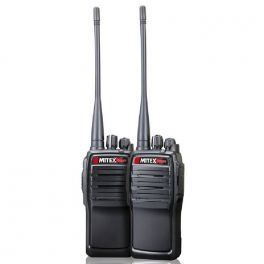
Mitex General Xtreme Licensed Radio Twin Pack
The Mitex General Xtreme Twin Pack is a set of two robust, heavy-duty two-way UHF analog radio talkies that work with existing Mitex models. With an IP66 rating, the walkie-talkies are resistant to dust, water, and vibrations, making them suitable for industrial, working, and outdoor environments. With high-quality audio design and strong antennas, rest assured that you will be heard clearly in all environments, taking your surroundings into account. This device will ensure that you are always within reach when in demanding conditions.
- Licensed communication: secure and private channels
- IP66 rated: water, dust, and vibration resistant
- Powerful 5-watt output, significantly extending the range
- Requires a license for operation
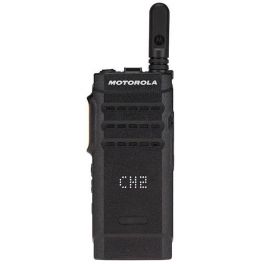
Motorola SL1600 UHF
The Motorola SL1600 is an ultra-slim, rugged two-way radio with intuitive controls, enhanced range, and IP54-rated durability, perfect for portable and reliable communication in various environments.
- 22mm thick, easy to carry in pockets or bags.
- Patented Range Max technology and long battery life.
- Supports both analog and digital modes with UHF and VHF models available.
- Requires an additional £10 per radio for programming.
- Active View LED display lacks advanced visuals.
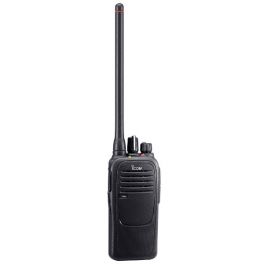
ICOM IC-F2000 UHF
The ICOM IC-F2000 is a compact, durable walkie-talkie with IP67 protection, motion sensor for emergencies, clear audio, and secure communication, ideal for harsh and demanding environments.
- Small size and 240g weight for easy portability.
- Motion sensor and emergency signaling for safety in critical situations.
- Channel announcement and selective call capabilities for group use.
- Lacks an advanced screen for visual navigation of settings or channels.
- Voice inversion encryption may not meet high-security needs.
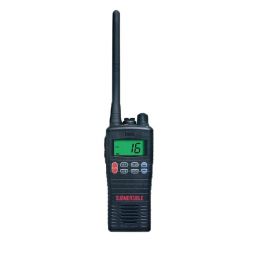
Entel HT644 VHF Marine Two Way Radio
The Entel HT644 is a rugged, marine-grade handheld radio with IP68 submersibility, pre-programmed marine and weather channels, advanced audio features, and intelligent battery technology, ideal for life at sea.
- Li-Ion battery with charge tracking and no memory effect for longevity.
- Large LCD display and glove-friendly 7-button keypad for easy operation.
- Channel scan, monitor, and a shortcut to channel 16 enhance usability.
- Limited appeal outside maritime environments.
- No modern features like Bluetooth or Wi-Fi.
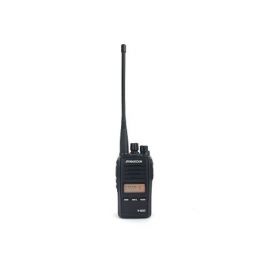
DYNASCAN V-600
The Dynascan V-600 is a durable, IP67-rated VHF walkie-talkie designed for hunters, featuring 128 programmable channels, an SOS emergency button, and compatibility with popular VHF models.
- Anti-shock metal structure ensures durability in tough environments.
- LCD display and keypad lock make it user-friendly.
- Compatible with Motorola GP340 VHF, DP1400 VHF, and CP040 VHF models.
- VHF operation requires a license, adding complexity.
- Missing Bluetooth, Wi-Fi, or GPS for extended functionality.
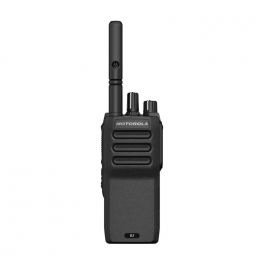
Motorola R2 UHF Digital
The Motorola R2 UHF Digital walkie-talkie combines durability, long battery life, and clear communication with advanced digital features, making it ideal for demanding work environments like warehouses and construction sites.
- High-density battery lasts through extended shifts with low battery warnings.
- IP55-rated and MIL-STD 810 certified for dust, water, and shock resistance.
- Supports DMR standards, advanced privacy, and transmission interruption for secure communication.
- 64 channels may not be sufficient for larger operations.
- Advanced features may be unnecessary for basic communication needs.
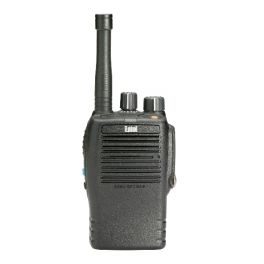
Entel DX482 - UHF
The Entel DX482 UHF is a rugged and versatile digital two-way radio designed for professional use in challenging environments. It operates in both digital and analogue modes, providing flexibility and compatibility with existing systems. The radio is IP68-rated for maximum protection against water and dust and features advanced audio quality with noise cancellation. It also includes programmable buttons, a high-capacity battery, and enhanced safety features, making it ideal for demanding work conditions.
- Dual-mode operation
- IP68 water and dust resistance
- Excellent audio quality
- Higher cost due to advanced features
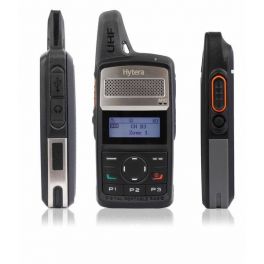
Hytera PD365 UHF + Traveling Licenses
The Hytera PD365 UHF walkie-talkie combines lightweight design, robust features, and digital/analog functionality, offering a compact solution for effective communication with up to 12 hours of battery life.
- Weighs only 160g, easy to carry for extended periods.
- Supports both digital (DMR) and analog modes for versatile communication.
- IP54 rating protects against dust and water splashes.
- Small LCD screen may not be ideal for detailed information.
- Lacks advanced features like GPS or emergency alerts.
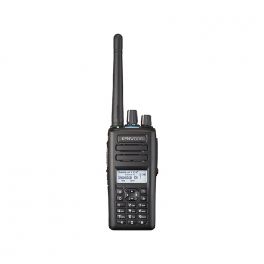
Kenwood NX-3220E VHF - with battery, antenna and charger
The Kenwood NX-3220E is a rugged, multi-protocol VHF walkie-talkie with advanced digital and analogue features, ideal for challenging environments, offering seamless communication, safety, and durability.
- Enables efficient fleet management and tracking.
- Illuminated keypad, backlit LCD display, and multi-colour LED indicators.
- Advanced features may require additional training to use effectively.
- Standard connector limits compatibility with third-party accessories.
QUESTION
What is the maximum range of a walkie-talkie?
Strictly speaking, there is no maximum range for licensed or unlicensed walkie-talkies, at least not from a technical point of view. In fact, the range of a licensed walkie-talkie depends on the coverage area requested from the department of communications when applying for a license, which can reach an unlimited number of kilometres, thanks to the installation of relays. It is true that licensed models are more powerful and therefore have a longer range. When we talk about the range of unlicensed models, there are manufacturers who advertise up to 12 kilometres, but it depends on the environment, and where you are going to operate. In urban areas, the range is drastically reduced by buildings and walls while in open fields the waves can circulate easier. There is no fixed answer to the range of a walkie-talkie.
Which walkie-talkie is the most powerful?
When measuring the power of a walkie-talkie, there are several key elements to consider: the transmitting power in watts and the environment of use. The UHF walkie-talkie model, whose power can reach 4W, is more suitable for professionals working in crowded areas (city, indoors, factories, etc.), as this UHF frequency can easily pass-through obstacles to ensure smooth communication. On the other hand, the VHF model, which is more powerful thanks to its 5W emission, should only be used for communications in open spaces outdoors, as it can only guarantee clear exchanges in open spaces. The power of a walkie-talkie does not depend on the number of watts emitted but, on the use made of it.
What are the origins of walkie-talkies?
The walkie-talkie, a portable communication system, was invented in 1937 and was originally intended for military use. Today, it is widely used by companies and outdoor enthusiasts (hunting, hiking, etc.), as it allows rapid communication in all types of environments.
How can I increase the power of my walkie-talkie?
The output power of a walkie-talkie must not be modified to exceed the set threshold. In case of reprogramming a walkie-talkie, the user is exposed to heavy prosecution, as specified by telecommunications law. The normal power of a walkie-talkie for free use is about 0.5 watts and 3.5 to 5 watts for licensed models. Therefore, please inform yourself, or consult our experts about the devices to avoid any violations.
What is the difference between an analogue and a digital signal?
There are currently two types of licensed walkie-talkies: analogue and digital. Although at first glance they appear to be the same, they differ in several respects, most notably in the audio quality of communications. Analogue walkie-talkies operate on a downward curve, which means that the quality of communication gradually decreases as the user moves away from the coverage boundary, while digital walkie-talkies operate on a constant curve, which ensures that the audio quality of the user's communication remains constant until the user moves away from the coverage area, at which point the ongoing communication is completely and instantly cut off.
